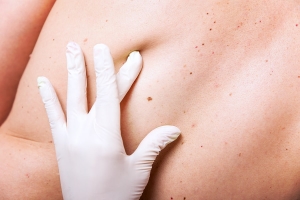Many moles, by their location, size and color, can both decorate a person’s appearance and disfigure it. We are all used to the usual brown moles, but there are also red moles, which in medical language are called ruby angiomas . These angiomas are benign tumor formations originating from blood vessels.
Red moles on the skin, therefore, are not real moles, as they develop from the endothelial tissue of a blood vessel. This type of formation can appear anywhere on the body, but most often occurs on the trunk.
What does an angioma look like?
Red moles on the skin look like spots of various sizes, usually from 2 to 5 millimeters in diameter, although in some cases they can be large. The shape is usually round or oval. As the name suggests, these formations have a red tint, which is often described as cherry red or ruby red . Angiomas can be flat or slightly raised, and because of this characteristic they resemble papules.
An interesting fact: although ruby angiomas can appear at any age, including in children, they are more common in older people.
What are the causes of red moles?
The formation of ruby angiomas is due to genetic changes in the endothelial cells of the capillary. Due to mutations, the cell begins to multiply uncontrollably, not obeying the mechanisms of cellular control. However, the true reason that leads to these genetic modifications and the subsequent appearance of red moles on the skin has not yet been fully elucidated.
There are many hypotheses formulated in this regard, and among the possible reasons considered responsible for the appearance of these benign formations, it is worth mentioning:
• genetic predisposition;
• hormonal changes;
• influence of UV rays ;
• liver disease;
• prolonged exposure to chemicals.
Differential Diagnosis
At the diagnostic stage, angiomas must be distinguished from other ruby-red spots, dots or blisters that appear on the skin for various reasons. These can be pathologies of an infectious nature, for example, chicken pox or measles, allergic diseases, dermatitis.
In general, distinguishing red moles on the skin from the above diseases is not particularly difficult. Plaques and red dots, which characterize infectious, allergic or dermatitis diseases of various types, usually occur in large numbers, affecting much larger areas of the skin.
When do you worry?
Ruby angiomas are not considered dangerous and usually cause no trouble to the patient. However, if certain symptoms appear or their morphology changes, it is advisable to contact a dermatologist at Bogolyuby Medical Center . Do not leave angiomas unattended if they:
• become itchy or painful;
• increase in size, especially in a short time;
• change color;
• appear in large quantities on one or more areas of the skin.
If any of these symptoms are present, the dermatologist may decide to conduct more in-depth studies, such as, for example, a biopsy, to determine the presence or absence of pathologies of a malignant nature.
Since angiomas are benign, they do not require treatment. However, if they bring aesthetic discomfort to the patient, they can be removed. In Bogolyuby Medical Center, angiomas are removed with a radioknife Surgitron .
In no case should you try to get rid of red moles on your own, as this practice can be dangerous. After an injury or cut, angiomas (especially if they rise above the skin) burst, causing more or less severe bleeding. In such cases, seek medical attention immediately.
















